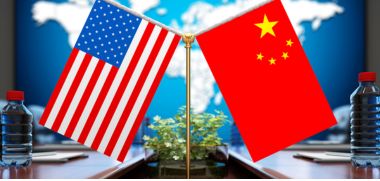- Courses
- GS Full Course 1 Year
- GS Full Course 2 Year
- GS Full Course 3 Year
- GS Full Course Till Selection
- Online Program
- GS Recorded Course
- NCERT (Recorded 500+ Hours)
- Polity Recorded Course
- Geography Recorded Course
- Economy Recorded Course
- AMAC Recorded Course
- Modern India, Post Independence & World History
- Environment Recoded Course
- Governance Recoded Course
- Science & Tech. Recoded Course
- International Relations and Internal Security Recorded Course
- Disaster Management Module Course
- Ethics Recoded Course
- Essay Recoded Course
- Current Affairs Recoded Course
- CSAT
- 5 LAYERED ARJUNA Mentorship
- Public Administration Optional
- ABOUT US
- OUR TOPPERS
- TEST SERIES
- FREE STUDY MATERIAL
- VIDEOS
- CONTACT US
China and the U.S. Extend S&T Cooperation Agreement for 5 Years
China and the U.S. Extend S&T Cooperation Agreement for 5 Years
27-12-2024

- In December 2024, China and the United States agreed to extend their Science and Technology Cooperation Agreement for another five years, effective from August 27, 2024.
- They also signed a protocol to amend the agreement. This move has been widely welcomed as a positive step toward sustained collaboration between the two global powers in science and technology.
Background of the Agreement
- Initial Signing: The agreement was originally signed in 1979, by Chinese leader Deng Xiaoping and U.S. President Jimmy Carter. This occurred shortly after the establishment of diplomatic ties between the two nations.
- Purpose: The initial focus was on cooperation in agricultural research and technology.
- Renewals and Scope Expansion: Since 1979, the agreement has been renewed every five years, with an increasing range of covered topics.
- Governance and Structure: The agreement is overseen by the US-PRC Joint Commission on Scientific and Technological Cooperation. Both countries appoint co-chairs for the commission.
Importance of Bilateral S&T Agreements
- Bilateral S&T agreements play a crucial role in fostering collaboration in science and technology.
- Often, these agreements are part of larger frameworks and promote joint research, student and scientist mobility, and institutional cooperation.
- They can lead to the establishment of bilateral research centres, even though they typically do not specify direct investments in S&T.
- India has entered into such agreements with 83 countries.
Key Changes in the Renewed Agreement
- Scope of Collaboration: Future cooperation is limited to intergovernmental initiatives, basic research, and pre-identified areas of mutual benefit (e.g., earthquake studies and basic health research).
- Critical and emerging technologies are excluded to prevent perceived imbalances, particularly accusations that China disproportionately benefits at the U.S.'s expense.
- Concerns Addressed: The U.S. has noted China’s ability to leverage the research ecosystem more effectively and raised intellectual property (IP) concerns.
- A 2017 Congressional Research Service report highlighted over 400 Chinese patents tied to Agreement projects that were commercialized without U.S. benefits.
- In response to growing tensions, particularly over technology exports, the renewed S&T agreement includes provisions for researcher safety and data reciprocity.
- Enhanced Researcher Safety: New provisions have been introduced to ensure the safety and security of researchers involved in collaborative efforts.
- Both nations are now obligated to follow guidelines that protect their respective research environments.
- Data Reciprocity and Transparency: To address past issues related to intellectual property and data misuse, the agreement includes new clauses ensuring mutual reciprocity and transparency in data sharing between the two countries.
- Dispute Resolution Mechanism: A structured mechanism has been added to resolve disputes in cases where either party fails to meet the agreed-upon terms.
- This provides a clear framework for addressing potential conflicts in collaborative projects.
- Termination Clause: The agreement now includes a provision allowing for the cancellation of proposed projects if “bad faith actions” are detected. This aims to safeguard against misuse of the cooperation framework.
What Does This Indicate About the Evolving U.S.-China Relationship?
The updated agreement highlights the nuanced nature of the U.S.-China relationship, marked by elements of both cooperation and competition:
- Affirmation of Cooperation: The renewal signifies a continued commitment to scientific collaboration and dialogue, despite rising tensions in areas like trade and technology.
- Strategic Guardrails: The introduction of restrictions and safeguards demonstrates the U.S.’s intent to protect its technological advancements while engaging in mutually beneficial research.
- This reflects a careful balancing act between fostering cooperation and addressing national security concerns.
- Political Dynamics: The incoming administration under Donald Trump is expected to support this agreement’s renewal.
- However, further conditions might be introduced, showcasing the ongoing political focus on China’s technological progress.
How Has the U.S. Benefited Under This Agreement?
- Access to Chinese Research Ecosystem: The agreement has opened doors for U.S. researchers to collaborate within China’s rapidly growing research landscape, allowing both nations to capitalize on their respective scientific strengths.
- Increased R&D Investment: The collaboration has encouraged significant growth in R&D spending by both nations.
- Since the agreement's inception in 1979, China’s R&D investments have increased tremendously, benefiting joint initiatives.
- Joint Research Opportunities: Collaborative efforts under the agreement have driven progress in fields such as agriculture, health, and environmental science, promoting shared knowledge and innovation.
- Educational Exchanges: The partnership has facilitated exchanges of students and scientists, strengthening educational ties and promoting understanding at multiple levels.
How Has the China Benefited Under This Agreement?
- Global Leader in Science: Over decades, China has grown into a global leader in science, supported by substantial investments in research and development (R&D).
- R&D spending rose from $375 million in 1979 to $442 billion in 2021, placing China second only to the U.S.
- Educational and Research Growth: The number of Chinese students in the U.S. rose from 2,770 in 1985 to over 109,000 by 2000.
- Collaborative research between U.S. and Chinese authors has expanded significantly, both in volume and across diverse fields.
How will it impact India?
- Increased Competition in R&D: China’s rapid advancements in technology and innovation, particularly in areas like AI, 5G, and quantum computing, pose competitive challenges for India’s R&D efforts.
- Geopolitical Leverage: India’s strategic ties with both the U.S. and other global powers may require adjustment.
- As the U.S. manages its dual approach of rivalry and cooperation with China, India’s diplomatic and technological engagements could experience significant shifts.
- Elevating role in the global scientific community: India’s expanding research ecosystem and established bilateral agreements in S&T position it as an alternative partner for nations seeking to reduce dependence on China.
- Strategic Technological Partnerships: India’s growth in critical sectors such as space research, IT, and pharmaceuticals will hinge on its ability to deepen technological and research partnerships with developed nations.
- Strengthening Bilateral Agreements: India must prioritize enhancing its S&T agreements with countries like the U.S., Japan, and European nations to secure a competitive edge in global innovation.
- Geopolitical Opportunities: The ongoing tensions between China and the U.S. create opportunities for India to bolster its strategic position. Alliances like the Quad allow India to align with the U.S. and its partners to counter China’s influence in the Indo-Pacific region.
|
Also Read |
|



